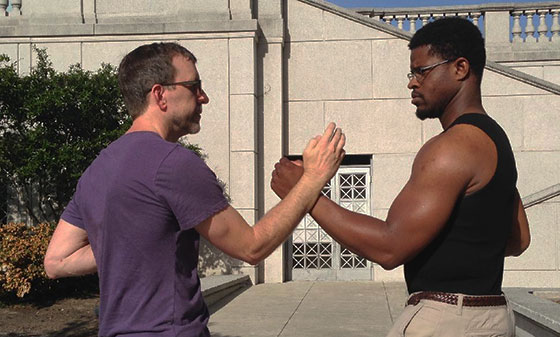
The Wing Chun Concept of a Bridge
October 27, 2015
Reader Question: “Steve, I have seen a Wing Chun maxim … that went something like: if your opponent has a bridge, take down the bridge, if your has no bridge, build a bridge, etc. Do you have the full maxim and information/ thoughts on how it is applied?
Thank you for you consideration of this question.”
Best, Howard
There are many Wing Chun sayings about the bridge – here are a handful:
“Create a bridge if the opponent’s bridge is not present; nullify the bridge according to how it is presented.”
“When chasing the opponent’s arm bridge , beware of being led.”
“The arm bridge tracks the movement of the opponent’s body; when the hands cannot prevail, use body position to save the situation.”
“If the opponent grasps your arm bridge , do not oppose him with brute force. Go with the opponent’s force and change into rolling hands.”
In one sense, the bridge is just your opponent’s incoming arm, and how we respond to that arm depends on its speed, structure, and direction. Thus you are advised not to oppose a “strong” bridge, but to go with it (“go with the opponent’s force”) and to change (“into rolling hands”). This means if you strike with a sun fist and encounter a strong bridge arm (they are strong or heavy or committed with their momentum), do a bong sau or a tan sau, depending on which direction the force can be most easily redirected (and ideally hit with the other hand , or flow into a pull or trip or both if their momentum is really strong).
You want to redirect incoming force, rather than try to meet power with power. This habit is best, even if the opponent is weaker, your habit will protect you when they are stronger/bigger. You want to always create habits that are universally useful against any size. Generally speaking, yield to the incoming force and find an unobstructed angle to your target (usually the head). Yielding in this sense still means going forward but not trying to stop the force.
The most important thing to think about a bridge in Wing Chun at the earliest stages stages of training is to understand that it is something you want . We are not boxers, using range-finding jabs. We want to end the fight fast. This means getting and exploiting the bridge to land our attack or counter-attack.
Lat Sau Jek Cheung, Loi Lau Hoi Sung. Receive what comes, follow what goes, upon loss of contact, rush in. Contact is the bridge. Receive it, follow it, do not be led by it (chasing hand). Seek it.
Wing Chun is the science of infighting . We want to fight “inside.” Very close. We call it “bent arm” or “tan sau” range. In the picture below, we are too far apart. I want to take another little step forward to be at “fighting distance” (where I can hit his head with my structured force). I don’t want to hit with an extended arm – practically all the force is already dissipated. We want all our strikes to count, if possible.
The 2nd Wing Chun form is called Chum Kiu. One translation of this form’s name is “bridge-seeking.”
When we are standing opposite what Rory Miller calls a “threat,” there are infinite mysteries. Will they hit or kick or pull a weapon or shoot like a wrestler? We cannot know because we are not mind-readers or Nostradamus or God.
How do we move from this position of infinite mystery (outside all ranges) to a “safe” position where we are hitting them in the head?

Wong Shun Leung reputedly started every fight with some sort of general “man sau” or seeking hand action. The opponent would defend against the perceived attack by raising one of their arms in a block. That block became Wong’s bridge. Once we have a bridge in Wing Chun, we have what we are after . Everything flows from this contact.
All your Wing Chun training is designed to develop reflexes , good habits which will usually guide you into positions from which you can hit, “safe” (temporary) positions of advantage. Wing Chun reflexes will also ideally flow in the moment as the “threat” responds with their random actions (hitting back, grabbing you. lunging forward or back, kicking, etc). You will make, keep, and let go of the bridges in accordance with their usefulness. That arm is temporarily defused, it can be temporally positioned so it is in the way of their other arm, etc.
If it crosses my body or passes behind me, I let it go and get back to hitting. Their defensive or offensive arm becomes my next bridge (a path I can cross into their “castle”).
Emphasis on the idea “temporary.”
We are talking tenths or hundredths of a second in a real fight. Even an average untrained person can throw two or three punches in a second. Double or triple that for Wing Chun fighters doing chain punching.
And you are always hitting with your bridge arm or the other arm. You are either hitting (attack and defense in the same action, as in a jaam deflection into a hit action with the one arm) or doing two handed actions (taan da, bong da, lap da). The “da” is the hit.
NOTE: Our goal is to hit the right place with a lot of force, backed by body weight and ground power, hitting repeatedly into a concentrated spot from a “safe” angle, not throwing a bunch of weak but fast punches haphazardly at the target, starting outside hitting range. Get in range and position, THEN hit! Line your body up to maximize your structure. Step in as you hit (take position).